
Although the collapse in maintenance demand caused by Covid-19 pandemic has been a nightmare for engine lessors, those with access to funds can also benefit from a superb opportunity to grow their portfolios.
Cash-strapped airlines are selling assets like spare engines to boost their liquidity, while many are at the same time transitioning up and away from current-technology equipment.
A recent example of both trends is SAS, which has agreed a sale and leaseback deal covering 20 IAE V2500 engines with Willis Lease Finance.
SAS expects to receive two Airbus A321LRs this year and 13 A320neos in 2022.
Globally, though, current-generation narrowbodies remain the bulk of the global fleet, so there is clearly value in Willis maintaining a strong position on their powerplants, even if it has been talking up a transition to new technology.
At the end of last year the lessor is believed to have finalized the purchase of 25 new geared turbofan engines from Pratt & Whitney.
In its more recent deal, the U.S. lessor said it had completed the purchase and leaseback of one of the V2500 aircraft engines, which power current generation A320-family aircraft, and anticipates closing on the remaining 19 with SAS by September 2021.
This follows a deal in March between the two parties in which SAS became the launch customer for Willis’ revolving credit lease financing product, in that case for spare CFM LEAP and Rolls-Royce Trent XWB engines.
Other engine sale and leaseback deals were conducted towards the end of last year by SMBC Aero Engine Lease (SAEL), which bought of eight CFM56-5B4 spare engines from Cebu Pacific Air, and three LEAP-1As from Indian carrier Vistara.





